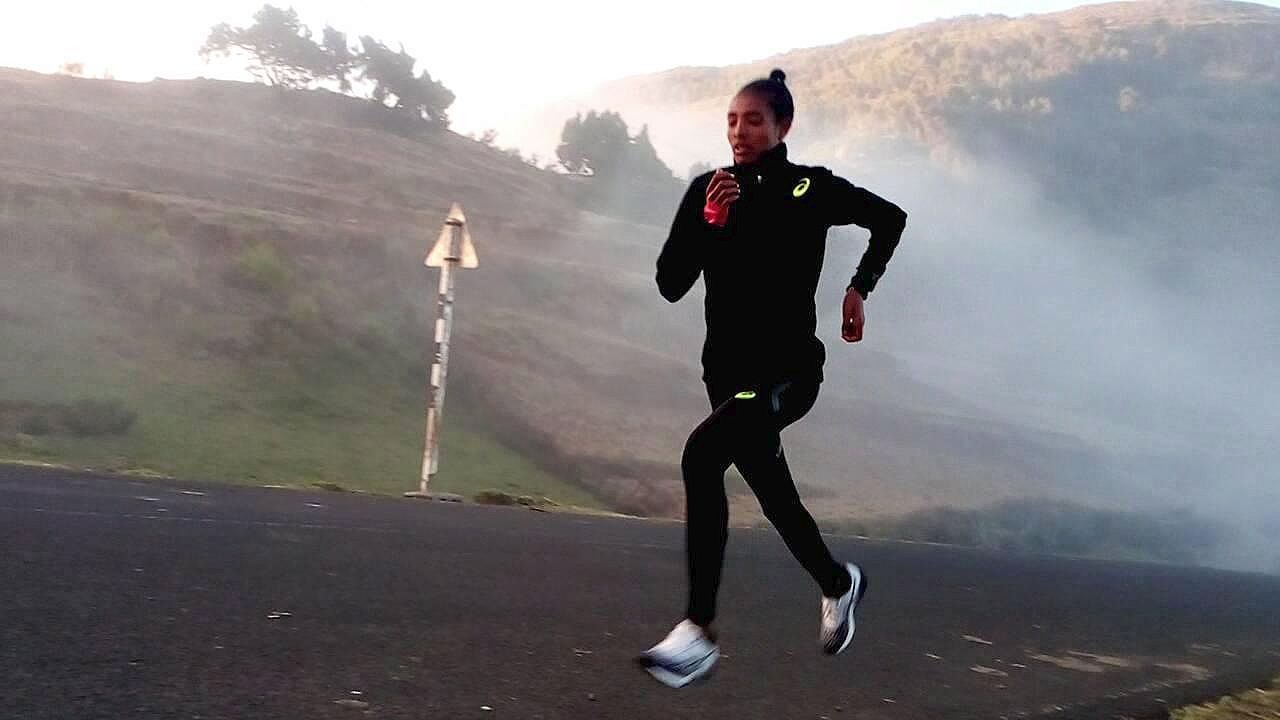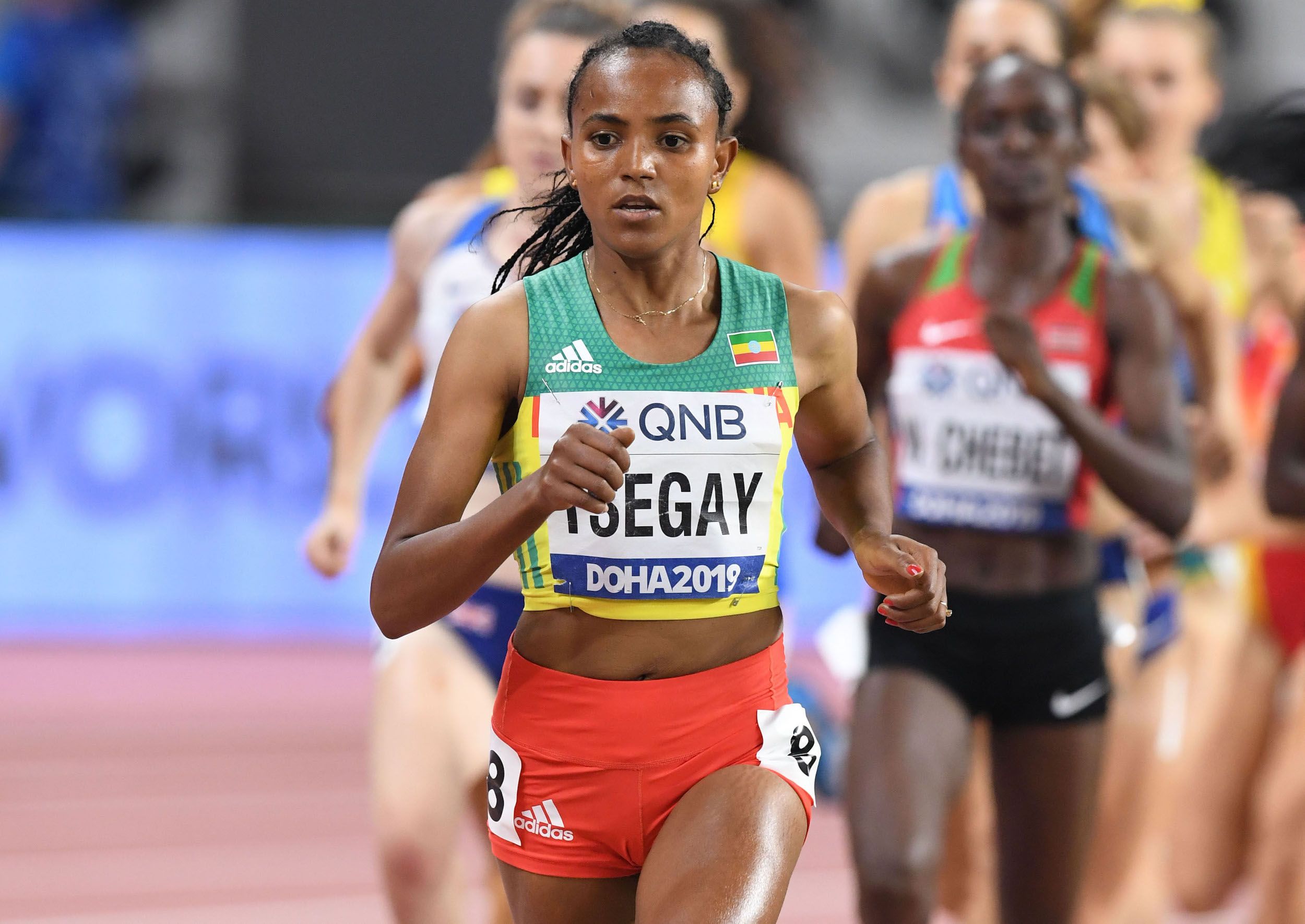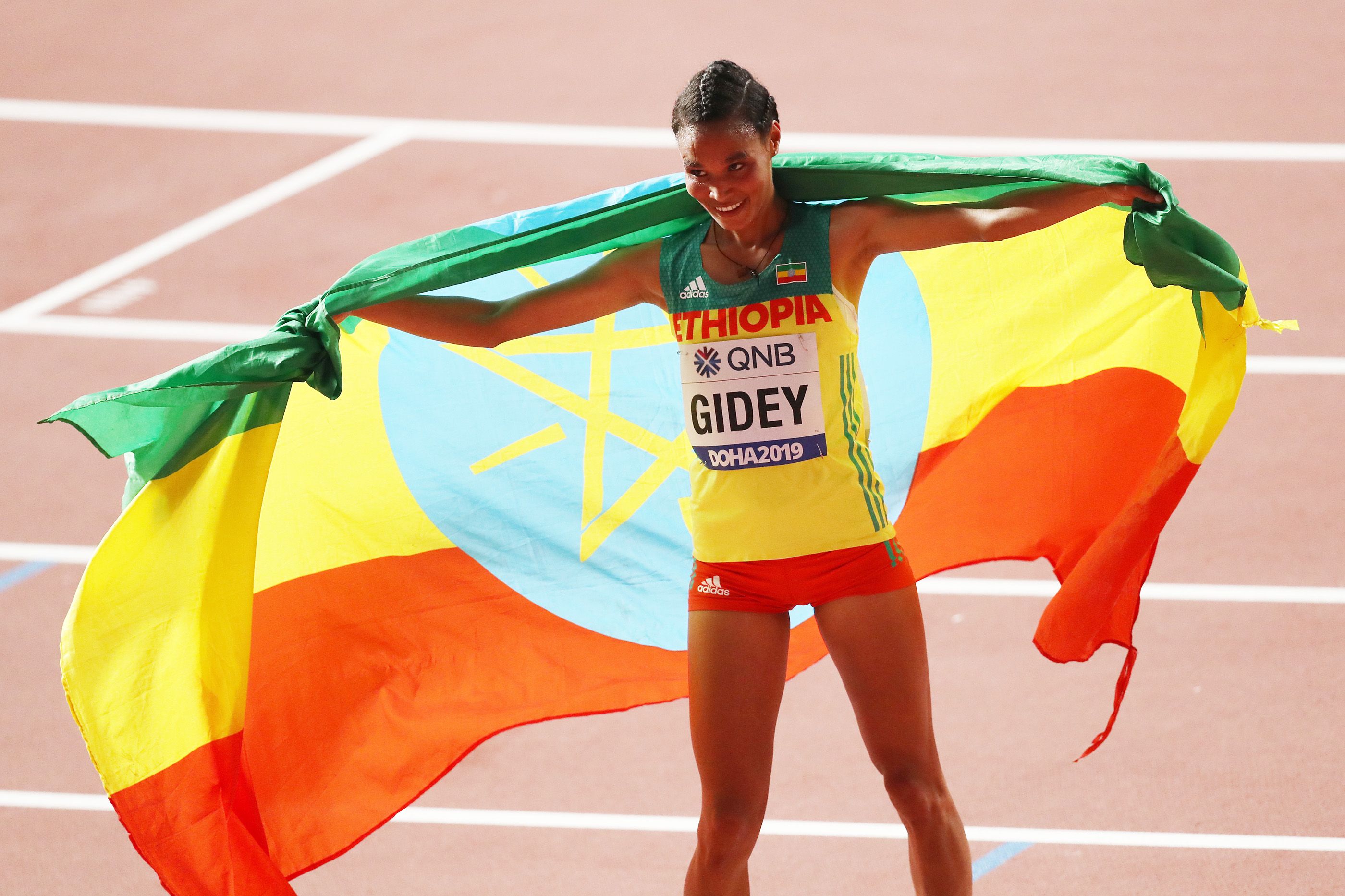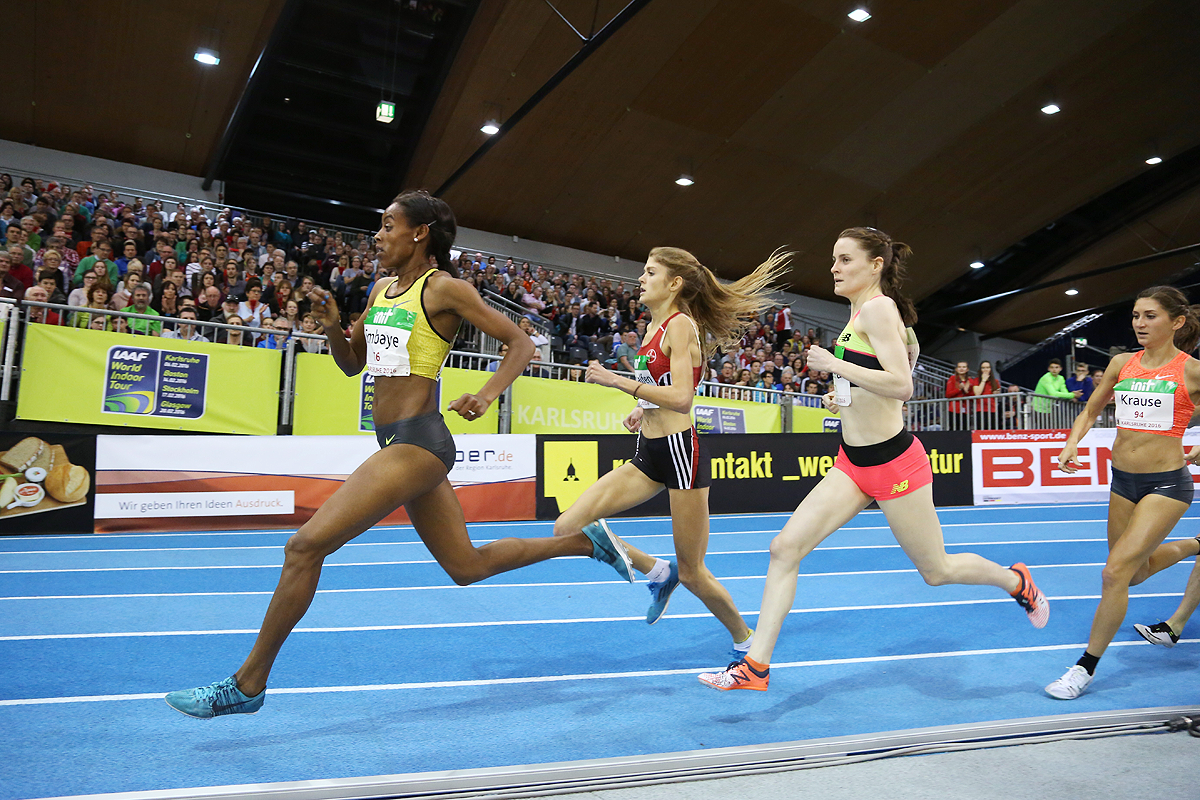Axumawit Embaye, Letesenbet Gidey and Gudaf Tsegay (© Gladys Chai von der Laage, Maja Hitij (Getty), Michelle Sammet)
Ethiopia is a place where grand narratives hold special and unique significance in the making of its culture, from historic battles for independence to the current humanitarian crisis sparked by fighting in the northern region of Tigray that has captured headlines around the world.
Just last week, on 1 March, Ethiopians celebrated an important national holiday – the 125th anniversary of the Battle of Adwa – commemorating a time when an Ethiopian army, led by Emperor Menelik II, overcame overwhelming odds to fend off invading Italian forces to maintain their independence. The battle and holiday commemorating Adwa helped to cement a sense of Ethiopian exceptionalism as a non-colonised country with a fighting spirit.
But equally as prominent within Ethiopian grand narratives are its counter-narratives.
At the moment, the conflict in Tigray means those narratives and counter-narratives are centre stage in national conversations. In November, forces aligned with the Tigray People’s Liberation Front (TPLF), the region's ruling party, attacked a federal military base in the region, prompting a response by federal forces. The deadly conflict has since caused thousands of deaths, produced widespread destruction and displaced more than two million.
Since the start of the conflict, power and network outages and limited media access have made it difficult to know what the lived experience is like on the ground in Tigray. Claims over who controls Ethiopia’s grand narrative are played out on a daily basis.

Tsigie Gebreselama training in Tigray
Tigray’s growing athletics heritage
In running, grand narratives have and continue to play a similarly important role.
Derartu Tulu’s 1992 Olympic 10,000m victory was a symbolic turning point in sport for women in Ethiopia and beyond. Being the first black African Olympic champion means Tulu is often referred to as “Queen.” Indeed, Tulu may very well be considered the “Taytu” of Ethiopian athletics, a reference to Menelik’s influential wife – part of a national royalty who, like Abebe Bikila, Haile Gebreselassie and Kenenisa Bekele came from Ethiopia’s central Oromia region. Several of Tulu’s female successors, like sensations Tirunesh Dibaba, Fatuma Roba, and countless others, also came from Oromia’s Arsi province south of Addis Ababa.
As home to such stars, Oromia is considered a place of athletic excellence. But women from other regions have been pushing against two co-convening narratives – that women can be as strong as men, and that they can be from anywhere in Ethiopia.

Gudaf Tsegay at the 2019 World Championships (© Gladys Chai von der Laage)
Ethiopia is made up of over 80 ethnic groups, the Oromo being the largest, making up around 35% of the population. Amhara follow with around 27%, with Tigrayans lying at a much smaller 6.1%. It is from this small, northern region, which shares a border and language with neighboring Eritrea, that some of Ethiopia’s most recent female talents have emerged.
The three women representing Ethiopia in the 1500m at the 2019 World Championships - bronze medalist and freshly-minted world indoor record holder, Gudaf Tsegay, her training partner Lemlem Hailu, and Axumawit Embaye - are all from Tigray. Other notable Tigrayan women paving new roads include 5000m world record-holder Letesenbet Gidey, Tsigie Gebreselama and Freweyni Hailu.
Many of these athletes share similar trajectories. Most come from families of farmers, who help produce Ethiopia’s native teff, and began their careers in sport by excelling at the local level. This was the case for Hailu, who stumbled into running by chance.
“In about grade seven I was just doing some sports in school, not a real race or anything, when I was noticed by a teacher,” she recalls.
Hailu comes from the kebele (ward) of Keyu Tekli, in the woreda (district) of Aleja, in the region of Tigray. In Ethiopia, administrative divisions are such that everyone is a member of a kebele, several of which make up woredas. If athletes can succeed in these regional competitions, they can usually progress to a larger city competition, where the opportunity to join a club may present itself.
“I was encouraged to train over the next six months and compete in the kebele and woreda competitions, to prepare for a race in Aksum,” Hailu says. After she won an 800m race in Aksum, the coach of a group in the Tigrayan capital Mekele asked her to join his club.
“My plans were to come to Addis Ababa quickly because it is much easier to travel to international competitions,” Hailu says. Luckily, she had a clear path to follow, eventually joining Hailu and Tsegay, who also come from Aleja.
Tsegay, who is just four years Hailu’s senior, was in the process of leaving a club in Mekele to move to Addis Ababa. In Mekele, Tsegay met her future husband and coach, Hluf Yihdego, also a long distance runner. Yihdego came to Addis Ababa a year earlier to join a government club but struggled with injuries. At that time, he and Tsegay decided it would be best for her to come to Addis Ababa, and for him to transition his efforts to helping her succeed.
“The transition to coaching was not easy,” Yihdego recalls. “There’s a lot more you have to focus on and think about when there are more athletes than just yourself.”
But Tsegay found success quickly in this transition, and both knew that more talent from Tigray was coming. Just after a few years of them training in Mekele, they saw that greater investment from within the region was producing more results.
Hailu was the second to join their group. “Even now there are not so many athletes that have come from Tigray,” Tsegay says. “But there are more than people know. There are more clubs and more athletes coming.” Both Hailu and Tsegay agree that they give each other confidence; when they train together and see the other succeed, it helps them believe they can rise to the top level of Ethiopian running.

Letesenbet Gidey at the 2019 World Championships (© Maja Hitij / Getty Images)
Their training group has expanded, bringing on other Tigrayan juniors and runners from other parts of the country. This has seen the language of instruction shift to Amharic to accommodate all athletes in the group, who are seeking to be a part of one of the premier middle distance training group in the country.
Shifting course in face of adversity
While this crop of Tigrayan middle distance runners has followed the traditional Ethiopian running trajectory of moving to the capital, others like Tsigie Gebresalama and Letesenbet Gidey headquartered their training in Tigray until recent events forced a move.
Gidey, who hails from Endameskel, also found success early on at the woreda level. But even as she went on to compete internationally in 2015, when she won the first of two back-to-back world U20 titles at the World Cross Country Championships, Gidey opted to make Mekele her training base.
Training with the Trans Sport Club and only travelling to Addis for competitions clearly served Gidey well, providing her with the focus required to break Tirunesh Dibaba’s 5000m mark, which had stood since 2008, by clocking 14:06.62 in Valencia in October.
Gebreselama, another rising Tigrayan star, was training in Mekele as well, choosing to base herself closer to family in Tigray. Now, however, due to the civil conflict, both long distance Olympic hopefuls can be found training in Addis Ababa.
Just a few weeks after Gidey broke the world record and returned to her home in Tigray, the Government’s advance in Tigray began. Electricity, mobile phone and internet connections in the area were shut down, making it difficult for her to communicate with family and friends. Violence in Mekele meant that most people sheltered for safety in their homes.

Axumawit Embaye in action in Karlsruhe (© Gladys Chai von der Laage)
Both Gidey and Gebreselama were slated to run road races late last year – Gebreselama a debut half marathon in New Delhi, India, in November, and Gidey a half marathon in Valencia in December – when reports began to emerge of entire villages being destroyed. Not only were the two unable to travel, but they spent weeks inside their homes as uncertainty swept through the region.
Since then, both have come to Addis Ababa to focus on their running, leaving their normal training routines and scenery behind. Gebreselama bounced back strong winning the Great Ethiopian Run in January while Gidey has settled into a training program in Addis Ababa.
“I never stopped training because of COVID,” Gebreselama says. “Only because of the war.” She admitted that conflict has affected her training, but says it won’t force her to stop. “I will keep training and pray to God for peace and success.”
Shared struggle, uncertain future
Gebresalama is not alone. Nearly all Tigrayans outside of Tigray, both athletes and non-athletes, are having trouble maintaining regular contact with those outside of the region.
“A lot of time the phones do not work,” Hailu says, adding that she is keenly aware that the conditions and related stress make it difficult for athletes still based in Tigray to continue training.
“When I started finding success my sister also started training, which made me happy,” she says. “But because of the war and the conflict she has not been able to train.” It’s a frustrating reality, because with the lack of a running tradition in Tigray, Hailu’s parents were initially skeptical at her decision to pursue sport.
However, these women will continue forging new pathways.
Although they do not train together, they share a sense of culture within Ethiopia that is uniquely Tigrayan. They speak a different language. Some bear traditional facial markings of small cuts along the edges of their eyebrows. They enjoy a regional cuisine known as tihlo - barley dough balls that are covered with meat and dipped in a spicy sauce.
But beyond that, these young women are together creating counter-narratives to the traditional athletic pathways. They are showing that the crisis unfolding in their region will not stop them from merely trying. In the midst of brutal conflict, in fact, they are proving they can excel.
Hannah Borenstein for World Athletics
*Note: updated for clarity on 11 March 2020.



